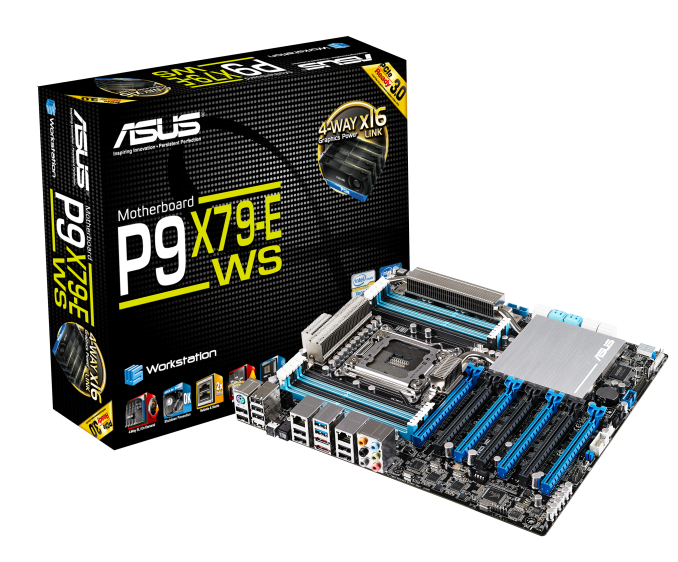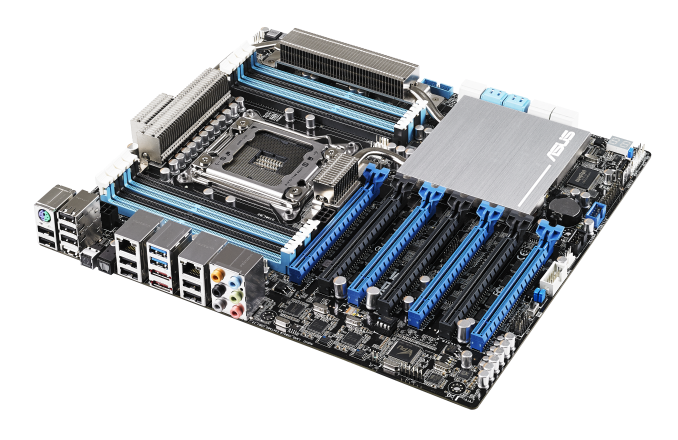ASUS P9X79-E WS Review: Xeon meets PLX for 7x
by Ian Cutress on January 10, 2014 10:00 AM EST- Posted in
- Motherboards
- Asus
- Workstation
- X79
- Prosumer
ASUS P9X79-E WS Conclusion
As mentioned in the outset of the review, workstation motherboards have not had much attention on AnandTech of late. They aim at a market almost more straightforward than the consumer market – they have to do a job, do it well, and remain stable. This is why Xeon processors and ECC memory compatibility are paramount, to go along with the extended or business oriented warranties and to be able to power mission critical systems without failure.
The market for prosumer level motherboards is a difficult one to gauge, especially in terms of numbers. ASUS have had WS models for several generations, and their competitors are certainly viewing it as a market with consistent sales – as a business customer the need for something that is powerful and stable is a path on the road to success.
ASUS have taken the standard P9X79 WS and essentially pimped it out with more of everything, as well as updating the package specifically of Intel’s Ivy Bridge-E consumer processors and Xeons. It does support ECC memory, albeit up to 64 GB is listed though it would be interesting to see 16GB ECC modules in place. One of the key features for the P9X79-E WS, and the ASUS WS range, is the level of validation testing of PCIe devices (RAID cards, GPUs, GPGPUs, sound cards, storage, and so on): while a consumer level product might have issues with a particular card, ASUS aim to make the WS series support it.
One of the main draws of the P9X79-E WS will be the numerate PCIe slots. Due to the use of PLX PCIe switches on board, these slots are wired for x16/x16/x16/x16 up to x16/x8/x8/x8/x16/x8/x8, and will accept Xeon Phi processing boards with the relevant BIOS switch activated. ASUS have only placed one 6-pin PCIe VGA power connector on board, which may not be enough for a potential total 525W power draw through these 7 slots (75W per slot). In order to help diagnose this, the Dr. Power circuitry added on board (with software in Windows) is designed to help should the power supply or motherboard be pushed for power draw.
Other functionality includes 12 SATA ports (6 PCH, 4 SATA 6 Gbps via Marvell, 2 eSATA), with the Marvell ports suitable for SSD Caching – whether SSD caching is suitable for 2014 is another matter. ASUS could have used the Intel C606 chipset to add SAS/SATA ports instead, but went down the X79+Marvell route. Despite no native USB 3.0 on X79, there are two USB 3.0 ports on the rear IO and a header on board. Alongside dual Intel I210 NICs we also get the Realtek ALC1150 audio codec, the high end audio codec from Realtek.
Due to the P9X79-E WS implementing MultiCore Turbo, our consumer CPU saw 4.0 GHz on any load, which allowed the P9X79-E WS to hit the top of the charts in many of our benchmarks, like other X79 motherboards that also enable MultiCore Turbo properly. Despite the focus on workstations, Xeons and ECC, there are minor overclock options which set our consumer overclockable CPU to 4.5 GHz with just a flick of a switch.
The BIOS is updated to the new ‘Z87’ generation, using features such as My Favorites, Quick Note and Last Modified as well as a fixed length font to aid user readability. The fan headers on board are designed to be controlled via the BIOS and the OS, with the OS software wrapped up in the X79/Z77 generation of AI Suite. This still includes features like Fan Xpert, USB 3.0 Boost, TurboV Evo, EPU, AI Charger and SSD Caching as mentioned before.
One issue I came across was that USB 3.0 Boost needed updating from the version on the CD (Turbo mode would not disable), and the other is the extended heatsink arrangement – due to the number of extra controllers and PCIe switches used onboard, the heatsink did heat up to be uncomfortable to touch. After speaking with ASUS, it was clear that they recommended a high airflow environment for workstation model products. The P9X79-E WS does come with a 3 year warranty and ASUS Premium Service for North America users.
The P9X79-E WS fits in that high end, prosumer niche. It is perhaps missing some features the high end performance needs (Thunderbolt, native USB 3.0), but that should be at the feet of Intel not updating X79 rather than ASUS. When a user is spending $560 to $3000 on a CPU (4930K or E5-26xx v2), then the motherboard becomes less of a % of the build overall and thus moving to a high end product is less of an overall percentage hit. This is the market ASUS is going for, and the P9X79-E WS goes well for the prosumer that needs as many PCIe slots with all the PCIe lanes as a motherboard can carry.












53 Comments
View All Comments
mapesdhs - Wednesday, January 15, 2014 - link
Makes perfect sense if you need to build something now. :D I've been talking to a movie
guy who's about to construct something based on this E revision. Similar to mine but better
GPUs, beginning with one 780Ti, expanding to 4 later. Only slight hitch is I've been trying
to convince him to use a Corsair H110 for the CPU instead of a big HS, the latter making
transport more difficult. Either way, it'll be a good AE system until he switches to a dual-socket
24-core XEON setup next year.
The only thing really missing from X79 (apart from a proper 8-core consumer chip option)
is more Intel SATA3 ports which don't suffer from the perils one can encounter with Marvell
ports. Both performance and reliability are better with the Intel ports, in some cases by a
huge margin. People harp on about USB3, but a lot of pro users I know rarely use it and if
they do need a USB link they're usually happy with USB2. Depends on the task though of
course, I'm sure some would find it important.
Ian.
almajnall - Wednesday, January 15, 2014 - link
hidzezik - Monday, February 10, 2014 - link
if You compare this funny mobo with professional supermicro e.g. X9SRL-F (7 PCIe slots for server use) or X9SRA for workstation it looks like a toy for kids. ASUS uses a lot of tricks but it cant overcome 40 lanes limitation from single CPU. motherboard is to complicated. 64GB of RAM is the limit? something is wrong with ASUS, Supermicro support 512GB. If You go for XEON chose Supermicro and Tyanmazzy80 - Friday, February 21, 2014 - link
Actually the SM boards look more like demo sample that a real board with so few surface Caps, Mosfet that this Board. :)The reality that they're not necessary to run the system at stock with the wide margin on Xeon about voltages.
BTW, the 64GB limit is about UDIMM Vs RDIMM, only on the C600 series the RDIMM & UDIMM are supported, on X79 only UDIMM.
P.S.
SM rocks, you can't really go wrong with them for WS/Server rig.
Hale_Kyou - Tuesday, March 4, 2014 - link
The 64 Gb limitation is in Intel Xeon and i7 CPUs, the same. For buffered memory. 500-700 Gb are supported with buffered memory on E5 Xeons only (E7 have hybrid controllers with external components). Buffered memory is MUCH slower than unbuffered due to penalties introduced by buffer and its latent logic. The same, inter-CPU RAM access introduces big penalties on multicore Xeon sustems. That's why sometimes (generally in HPC simulations) single core system with unbuffered RAM is preferred.Hale_Kyou - Tuesday, March 4, 2014 - link
there's a typo. Of course 64Gb limitation is for unbuffered RAM both in Xeon and i7. The limitation is removed on latest server-oriented Atoms.EdB1 - Thursday, July 31, 2014 - link
Hi djezik, although your post is fairly old, I had a look at the two board you mentioned, and they don't have the same PCI-E lanes expansion capabilites as the P9X79-E WS board, which has 72 PCI-E lines, due to 2 additional PLX chips, and can run at 16x x 4 slots at full speed or 2 x 16x and 5 x 8x, the two boards you mentioned do have greater mem capacity though, ie; 512GB ECC vs 64GB ECC or non ECC.So it really depends what you need this board to do. If you want to put 4 x 16X graphics cards in at once and don't need more than the 64GB ram limit, then this is the board to get, but if you do need more that the 64GB then the ASUS should not be considered.
Hale_Kyou - Monday, March 3, 2014 - link
Liars! x79 DOE NOT support "full turbo mode (4.0 GHz) no matter the loading""One new feature called ASUS Ratio Boost is in the BIOS, which implements MultiCore Turbo for Xeon CPUs"
Is a lie, according to ASUS itself. I don't know why did they trick people this dirty way. Maybe Intel pays them for spreading weird rumors. But ASUS says that turbo bins can not be reconfigured on their boards for XEON CPUs!
Hale_Kyou - Monday, March 3, 2014 - link
P.S. Of course it works on i7, that's why they lied about Xeon, but "proofed" with screenshots only with i7X running "all core full turbo".ReneGQ - Thursday, March 13, 2014 - link
I recently purchased an Asus Motherboard and the problems started from day 1. The drivers update never works, the same for AI Suite III (there´s a lot of updates for this model in Asus webpage). After 2 months I still can´t install BitDefender cause a clock watchdog error.Asus technical support is the worst, mails comes and goes with no solution.
I will not recommend this brand to anyone. The brand has a very good Marketing but the product and the service are very disappointment.